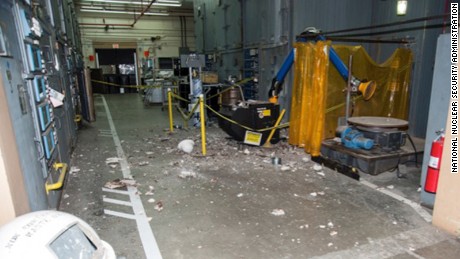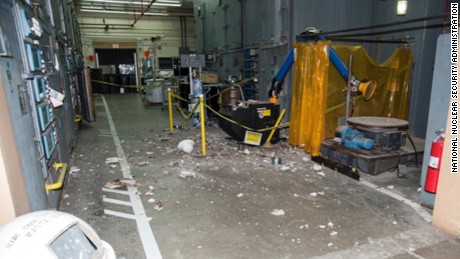Photos show nuclear facilities in dangerous disrepair

Washington (CNN)US nuclear security facilities are dangerously decrepit and putting national security goals at risk, according to nuclear officials who are asking Congress to back the administration’s push to modernize the system.
Nuclear officials described critical utility, safety and support systems that are failing at an increasing and unpredictable rate, as well as their efforts to patch the system together until the necessary funding can be found to reinvigorate the system.
“Safe, reliable and modern infrastructure at the National Nuclear Security Administration’s national laboratories and production plants is absolutely essential to the accomplishment of our vital national security missions,” NNSA Administrator Lt. Gen. Frank Klotz told the House Subcommittee on Strategic Forces Wednesday, according to his prepared remarks.
Committee members called Klotz and other officials to discuss the growing backlog of work needed at the country’s nuclear facilities, which include iconic places such as the Los Alamos National Laboratory. At the end of fiscal year 2015, the total cost of deferred maintenance across all NNSA property stood at $3.7 billion, Klotz said.
There is “no obstacle that poses a bigger risk to the long-term success” of the nuclear mission than this aging infrastructure, said Klotz, who stressed that nuclear deterrence is essential not only to US national security, but to the security of US allies as well.
The physical state of the US nuclear complex is in such bad shape because many key facilities were built during World War II and intended to operate for as little as one decade, according to Morgan Smith, president and CEO of Consolidated Nuclear Security.
Today, more than half of NNSA’s approximately 6,000 real property assets are over 40 years old, and nearly 30% date back to the Manhattan Project era, Klotz said.
“Many facilities and their supporting infrastructure have exceeded or far exceeded their expected life,” Smith told the committee, according to prepared remarks, “and major systems within the facilities are beginning to fail.”
Klotz outlined steps his administration has taken to control the maintenance backlog, including better documenting need maintenance, disposing of unneeded facilities and introducing a new budget structure. But he and others stressed that they need more resources.
Energy Secretary Ernest Moniz has pushed to stop the growth of deferred maintenance across the nuclear security enterprise, Smith told lawmakers, “but significant investment is required to appreciably reduce that backlog and sustain safe operations for the extended life of these vital mission facilities.”
In December, Moniz wrote to the Office of Management and Budget to say that their proposed nuclear budget for fiscal years 2018 to 2021 “doesn’t reflect the funding that we estimate is necessary.” He asked for an additional $5.2 billion for that time period, saying that the OMB proposal “ignores or underfunds” nuclear needs.
“Events elsewhere in the world reaffirm the seriousness of the threat environment in which we live,” Moniz wrote, “and underscore the need for a credible nuclear security program portfolio.”
Smith’s Consolidated Nuclear Security manages and operates the Y-12 National Security Complex in Oak Ridge, Tennessee, and the Pantex Plant in Amarillo, Texas.
Y-12, originally established in the 1940s as part of three Manhattan Project sites where the nuclear bomb was first developed, is now the country’s primary storehouse of highly enriched uranium and the place where highly enriched uranium components are manufactured, dismantled and tracked.
The Pantex Plant in Amarillo, Texas, the only plant in the nation where nuclear weapons are assembled and disassembled, was built in the1950s.
Smith shared descriptions of some Y-12 buildings in his written testimony that mentioned leaking roofs, “large patches of rust and corrosion on interior walls,” and other examples of “neglect and deterioration.”
The aging systems can also affect production and safety, Smith said. He gave, as one example, a production shutdown at Y-12 because of unplanned outages to humidity control equipment.
“The primary concern with knowingly deferring maintenance is that a major, unforeseen failure could occur,” Smith said.
Gen. Robin Rand, commander of the Air Force Global Strike Command, said he was “acutely aware” of the risks posed by the crumbling infrastructure and thought about it when considering missions.
“There will come a point when I can’t do it with existing capabilities,” Rand said. “We need to modernize.”
Adm. Cecil Haney, the commander of United States Strategic Command, pointed out that Russia has been modernizing their nuclear capabilities and alluded to comments by Russian officials indicating they believe the use of some nuclear weapons is acceptable.
The modernization, along with the “provocative nature of statements that have been made by Russian leaders and the display of their capabilities such as long-range strategic air flights in other areas in the world … when you add them all together, it is not in a good place,” Haney said.
Read more: http://www.cnn.com/2016/09/07/politics/nuclear-facilities-bad-conditions-photos/index.html
